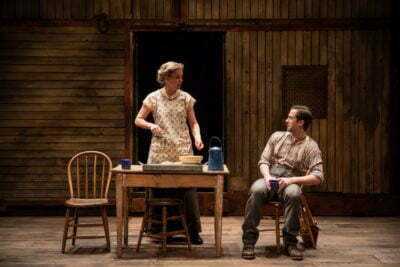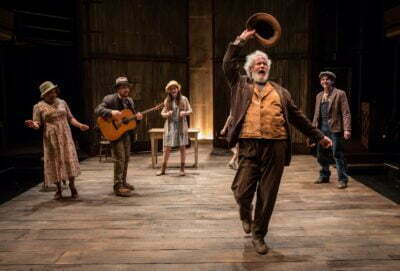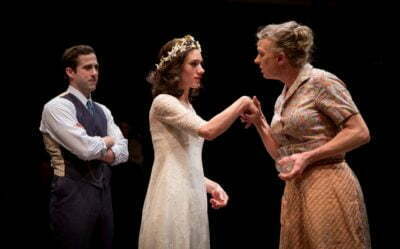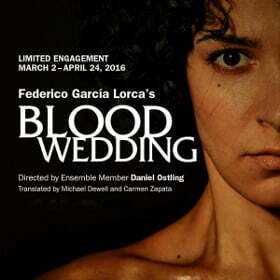Blood Wedding
By Federico García Lorca
Translated by Michael Dewell and Carmen Zapata
Directed by Daniel Ostling
Produced by Lookingglass Theatre Company, Chicago
A Pallid Dream Wedding
When Federico García Lorca was writing Blood Wedding in 1933, he was also developing his dramatic concept of “duende.” Inspired by the flamenco dancing of Andalusia and the Romantic concept of the ineffable, duende is a tone which is erotic, deathly, and, of course, dream-like. So it makes sense that director and scenic designer Daniel Ostling would be fascinated by it, and want to locate a little duende in the United States. It’s also disappointing how plodding and unfeeling his Blood Wedding is, in a rare misstep for Lookingglass.

The story begins with the Bridegroom’s Mother (Christine Mary Dunford) complaining about the pervasiveness of violence, and cursing the man who first invented weapons. Even her kitchen knife is not spared condemnation, so strong is her anger over the slayings of her husband and older son by the Felix family. The Bridegroom (Chance Bone) loves her, but is uninterested in her prattling. Now that he has acquired a vineyard, he can justify marrying the Bride (Helen Sadler), and her father (Troy West) is thrilled at the prospect of their farms being joined. But the Bridegroom’s Mother is displeased. None of her circle of friends know very much about the young woman, except that she used to be involved with Leonardo (Kareem Bandealy), a passionate young man now married to someone else, and a member of the Felix family.

Leonardo’s wife (Atra Asdou) tries to convince him to remain with his infant son, but it is no use. Leonardo is still in love with the Bride, and she with him. He visits her on the day of the wedding, and they initially attempt to control themselves in order to avoid a scene. The Bridegroom’s Mother would like nothing more than to fight, and she’s fiercely protective of her son. But eventually, infatuation overpowers reason, and the illicit lovers slip away to resume their affair. The Bridegroom’s Mother declares a resumption of the feud, and The Bridegroom sets out with his own weapons, intent on revenge.
On paper this sounds like a compelling love triangle, but in practice, it is difficult to care even slightly about any of the people involved. In Lorca’s last play, Bernarda Alba and Her House, each character was psychologically distinct and had their own motivations, which led to their tragedy. In Blood Wedding, Lorca was trying for something more universal, but at least in Michael Dewell and Carmen Zapata’s translation, everyone just comes across as flat and stilted. Most of the actors don’t contribute any choices about their characters either, so they’re difficult to describe in any other terms than their role in the plot. The Bridegroom’s Mother and the Bride’s Father brag about their children’s expected fecundity, and Lorca, like Tennessee Williams after him, put all of his praise for male beauty into the mouths of his female characters, while neglecting to have his male characters ever express attraction to women. But the attraction is non-existent on all sides here despite how much it is discussed.

Part of Ostling’s concept was to move the story’s location to California’s Central Valley, under the dubious reasoning that Lookingglass’s audience would identify more readily with this environment. To that end, he has enlisted self-described pop-rock artist Ricks Sims to compose folk-inspired music which the actors perform throughout the production, although their vocals are only adequate as both singers and speakers (and this play has some long speeches). Dewall and Zapata’s language also doesn’t fit with Ostling’s concept: the characters still refer to friends coming in from the “coasts,” plural, which wasn’t likely in the United States in the 1930s for people of this class, and there are other, similar references that are distinctly Spanish.

The most distinctive feature of this production is how, following the first two acts, it abruptly transitions into symbolism. For this reason, it is also an unusual example of a two-hour long play with two intermissions, which disrupt the flow of the piece. The levitating piano, hunter’s moon that hunts humans, and perverted old traveler are a welcome change of pace, although they can’t hold off the return of the underwhelming poetic monologues forever. But this change also allows Ostling to introduce more imaginative visuals, which are the production’s greatest strength. It’s too bad that the human elements are so much more restrained and indecisive than the design, but Blood Wedding still has some value.
Somewhat Recommended
Jacob Davis
[email protected]
Reviewed March 12, 2016
This show has been Jeff recommended.
For more information, see Blood Wedding’s page on Theatre in Chicago.
Playing at Lookingglass Theatre, 821 N Michigan Ave, Chicago. Tickets are $40-75; to order, call 312-337-0665 or visit lookingglasstheatre.org. Performances are Wednesdays at 7:30 pm, Thursdays at 7:30 pm (with performances on select dates at 2:00 pm), Fridays at 7:30 pm, Saturdays at 2:00 pm and 7:30 pm, and Sundays at 2:00 pm (and on select dates at 7:30 pm) through April 24. Running time is two hours with two intermissions.

